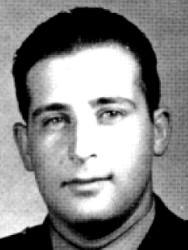Cap. Lee Silver (1923 – February 23, 1945)
232nd Infantry Regiment, 42nd Infantry Division
Written by Ryan Blount
On January 5, 1945, First Lieutenant Lee Silver earned a silver star near the town of Herrlisheim, France. Enemy forces pinned down and cut off Silver and the G Company from the rest of the 232nd Infantry Regiment. No longer able to communicate with his regiment, Silver took it upon himself to make a lone run into enemy positions, with gunfire raining down on him. He took multiple trips during intense fighting to reach his commanding officers and relay important information and messages. This process became even more difficult as enemy forces eventually surrounded the company. For his bravery, his commanders awarded him the Silver Star and promoted Silver to Captain.1
Early Life
Lee Silver, a Jewish-American, was born in Salt Lake City, UT, around 1923, to Herman and Dorothy Silver.2 The Silvers, born in the 1880’s, immigrated from the Austria-Hungarian Empire in the early twentieth century.3 Like many Eastern Europeans that immigrated during this era, the Silvers likely came to New York to escape persecution and to find better economic opportunities.4 Silver’s older sisters, Dorothy and Helen, were born in New York.5 At some time in the early 1920s, his parents moved west to Utah, where Lee was born. During his childhood, they returned to Troy, NY, around 1935 and stayed there for some time. The family moved again and appeared on the 1940 Census at 1572 Meridian Avenue in Miami Beach, FL.6 Lee attended Miami Beach High School and graduated in 1940.7
Military Service
With the United States entering the war, Lee joined or was drafted into the Army, and assigned to the 232nd Infantry Regiment, 42nd Infantry division.8 This unit was reactivated on July 14, 1943 at Camp Gruber in OK.9 Silver’s division was nicknamed “Rainbow” because the earlier division consisted of National Guard units that stretched across 27 states. It was the most famous fighting division of World War I. General Douglas McArthur, a member of the “Rainbow” division, made a speech upon reactivation saying “the rainbow stretches across the land and represents the people of our country. This division cannot fail, because America cannot fail.”10
When the 42nd Division entered the war, the Army split it into two groups. One group left for France on November 13, 1944 and were in the foxholes along the North side of Strasbourg on the Rhine River when they met up with their counterparts on Christmas Eve, 1944. Lee and the 232nd Infantry Regiment took up on the north flank of Strasbourg, opposing the German forces on the other side of the Rhine River. The Germans knew that there were new enemy forces across the river and decided to send a boat patrol to retrieve information by capturing an enemy soldier. However, heavy machine gun fire halted this boat patrol. The two sides continued small firefights until January 4, 1945, when G Company moved to the town of Offendorf, to fill a gap in the 1st and 2nd Battalions of the 232nd Regiment.11
The Germans put the “Rainbow” Division to the test on January 5, when they launched major attacks on the towns of Gambsheim, Offendorf, Kilstett, and Herrlisheim. During the battle at Herrlisheim, Silver’s commanders noted him for heroism, awarded him the Silver Star, and promoted him to the rank of captain.12 The battle, however, caused major casualties for G Company which forced it to retreat. Even though they lost the battle, “Rainbow” Company continued to fight on this front until January 27, 1945, when the military command relieved them from combat.13
The 42nd Division remained out of combat until February 14, 1945, when they received orders to move into Wimmenau and Wingen-sur-Moder located in the North part of the Alsace region, France. The 232nd Infantry Regiment completed 38 reconnaissance patrols, along with 36 combat patrols in a little over ten days. During these patrols, two soldiers were killed, sixteen were wounded, and two went missing.14 Captain Lee Silver was among the casualties. He died on February 23, 1945.15 By the time Germany surrendered, on May 7, 1945, the “Rainbow” Division had served 114 days in combat and advanced 450 miles to the Austria Border.16 The US Army buried Captain Lee Silver at the Epinal American Cemetery in France with his fellow soldiers who perished in World War II.17
1 “Capt. Lee Silver,” Find A Grave, accessed March 20, 2016, https://www.findagrave.com/memorial/56375510/lee-silver.
2 Miami Beach High School 1940 Yearbook, 84, database, Ancestry.com. (http://www.ancestry.com: accessed March 20, 2016): see image at the RICHES Epinal American Cemetery Collection here; “1940 United States Census,” database, Ancestry.com. (http://www.ancestry.com: accessed March 20, 2016), entry for Lee Silver, Miami, Dade County, Florida: see image at the RICHES Epinal American Cemetery Collection here.
3 “1940 Census,” entry for Lee Silver.
4 Immigration Library, accessed March 22, 2016, http://www.energyofanation.org/waves_of_austro-hungarian_immigration.html.
5 “1940 Census,” entry for Lee Silver.
6 Ibid.
7 Miami Beach High School 1940 Yearbook.
8 “Lee Silver,” American Battle Monuments Commission, accessed March 22, 2016, https://www.abmc.gov/node/404991#.VvFYM_krKUk.
9 Hug C. Daly, 42nd “Rainbow” Infantry Division: A Combat History of World War II (Baton Rouge: Army & Navy Publishing Company, 1946), 3.
10 Ibid, 3.
11 Ibid, 13 – 15.
12 “Capt. Lee Silver,” Find A Grave.
13 Daly, 42nd “Rainbow” Infantry Division, 21, 36.
14 Ibid, 36 – 37.
15 “Lee Silver,” American Battle Monuments Commission.
16 Daly, 42nd “Rainbow” Infantry Division, 3.
17 “Capt. Lee Silver,” Find A Grave.

